Charles E W Bean, Diaries, AWM38 3DRL 606/259/1 - 1917 - 1927 - Part 3
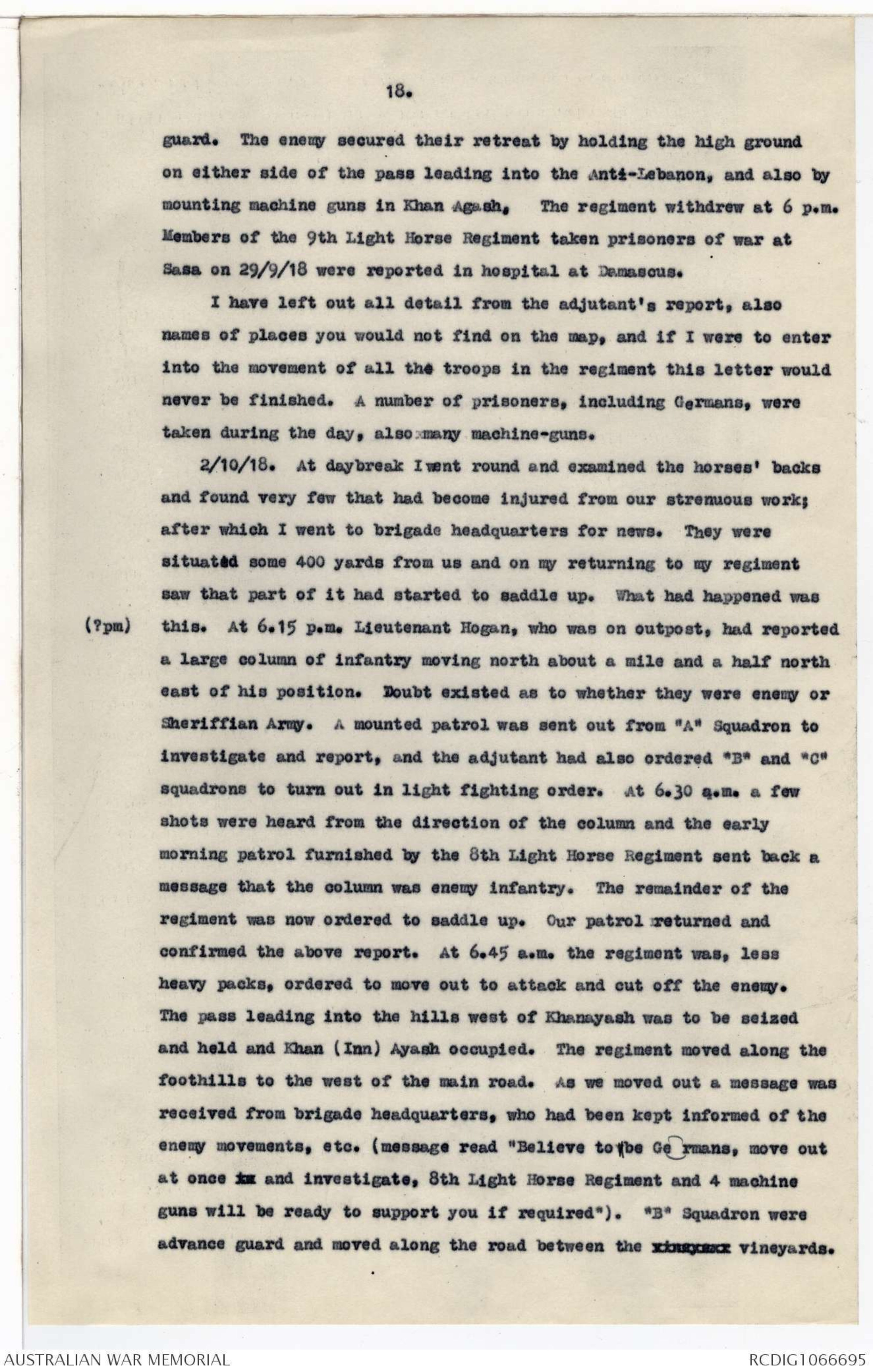
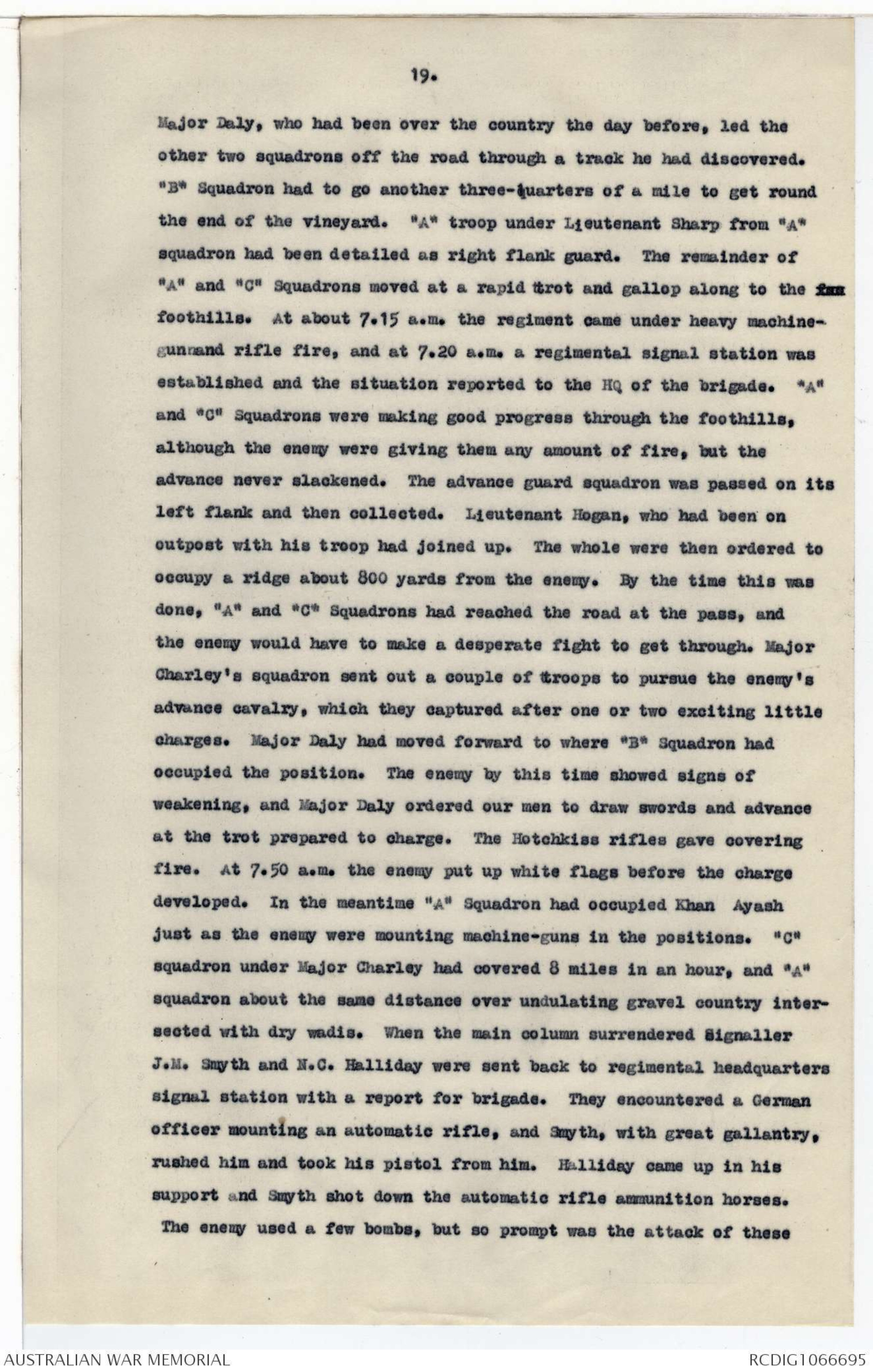
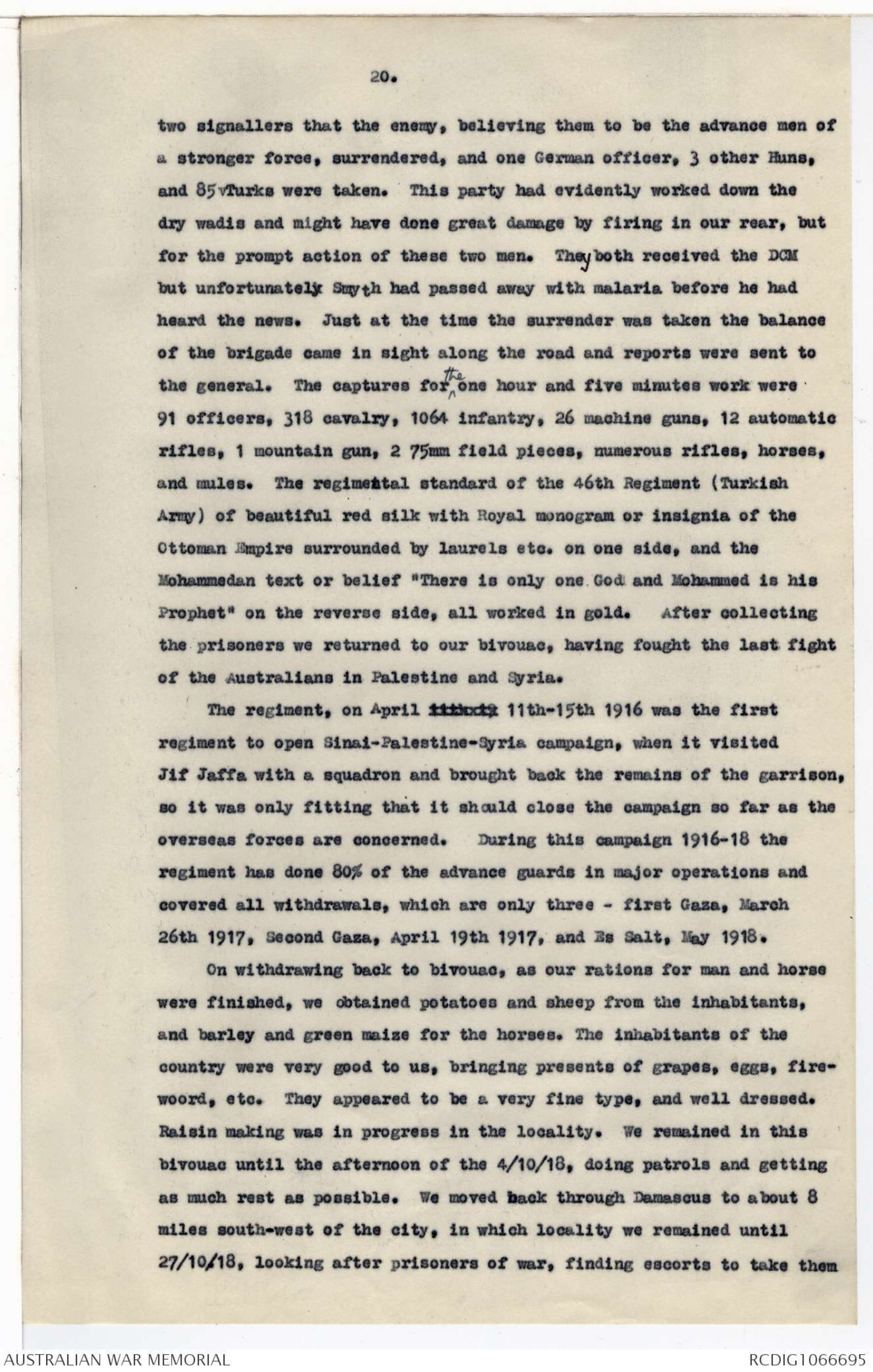
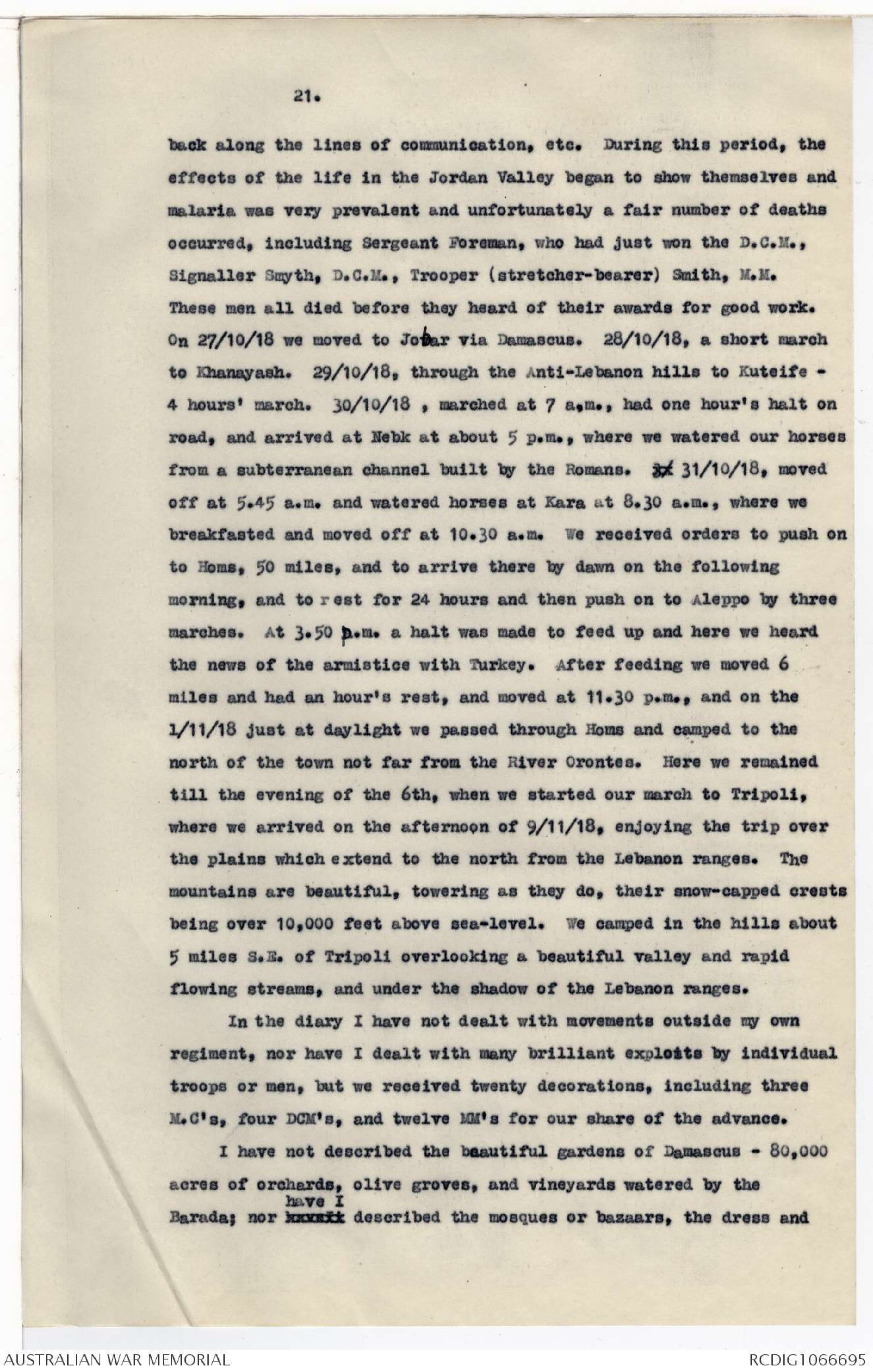
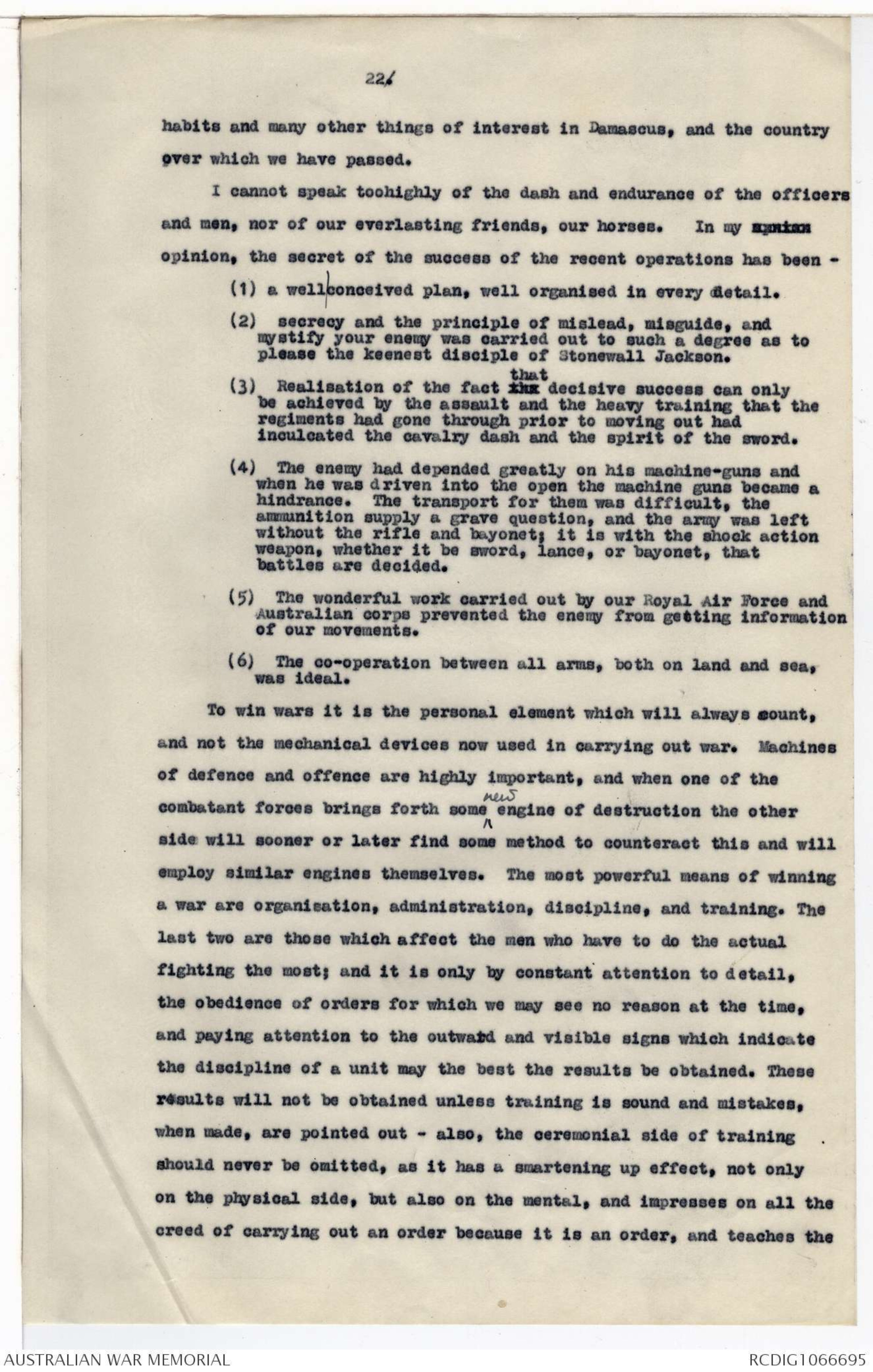
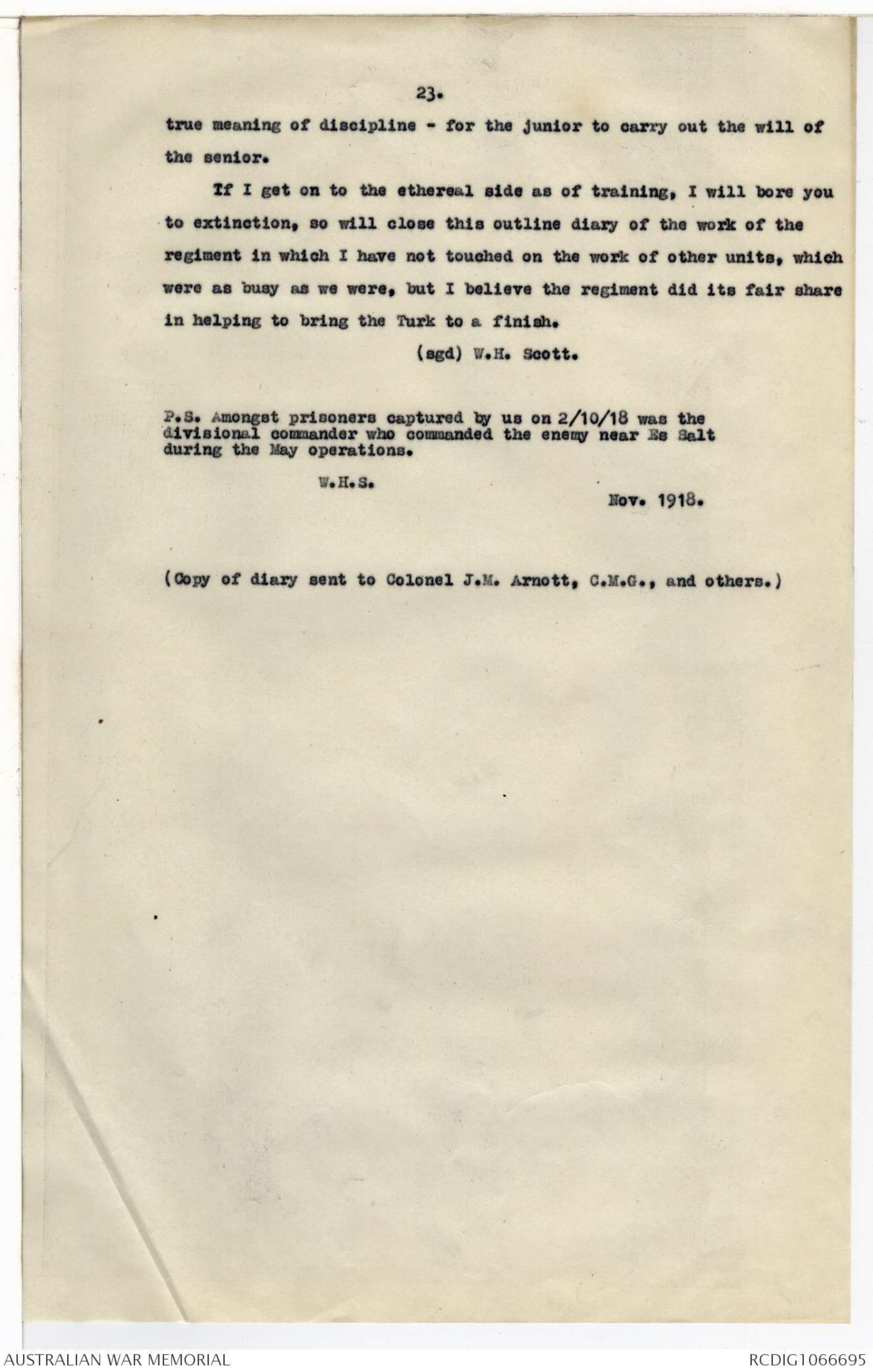
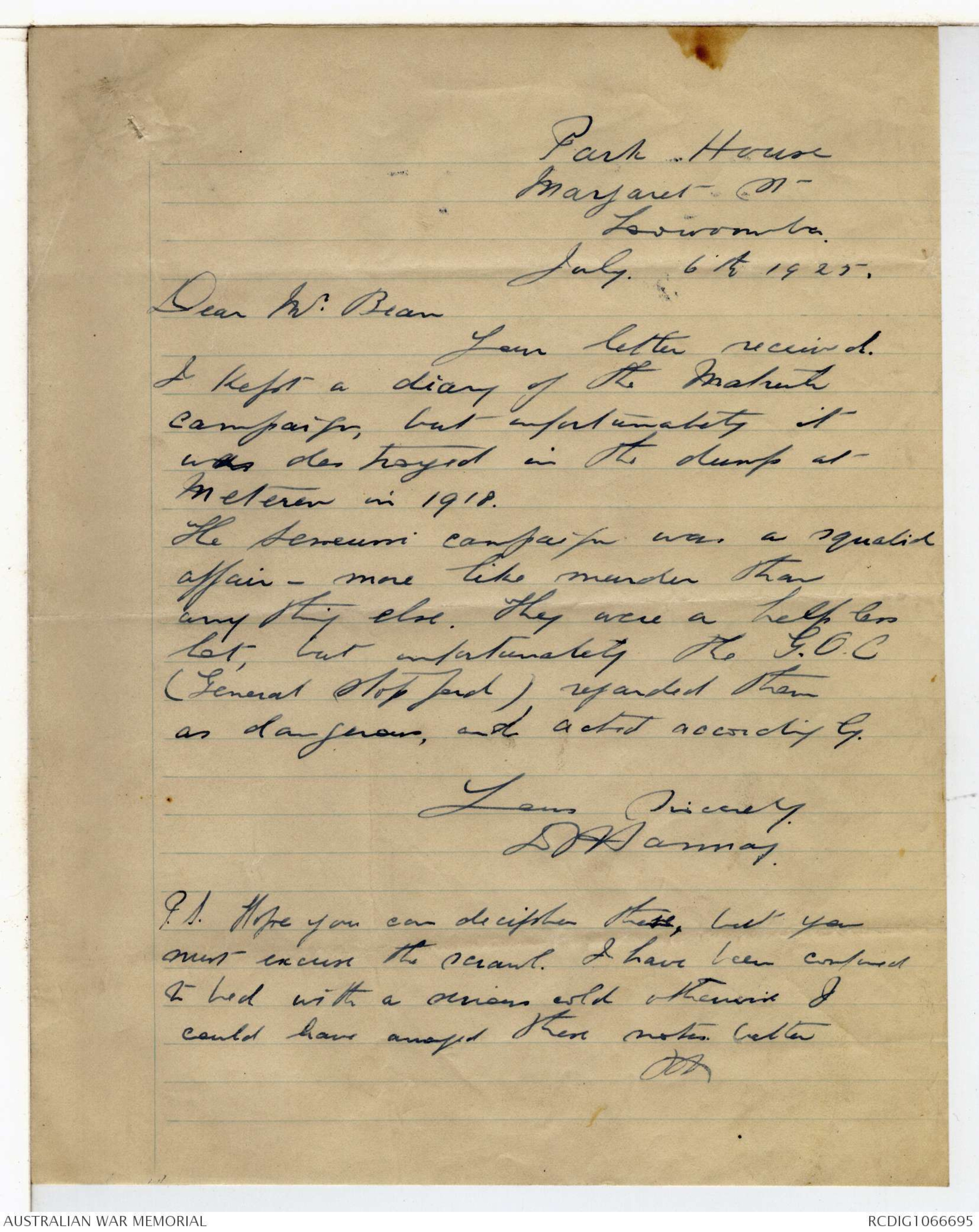
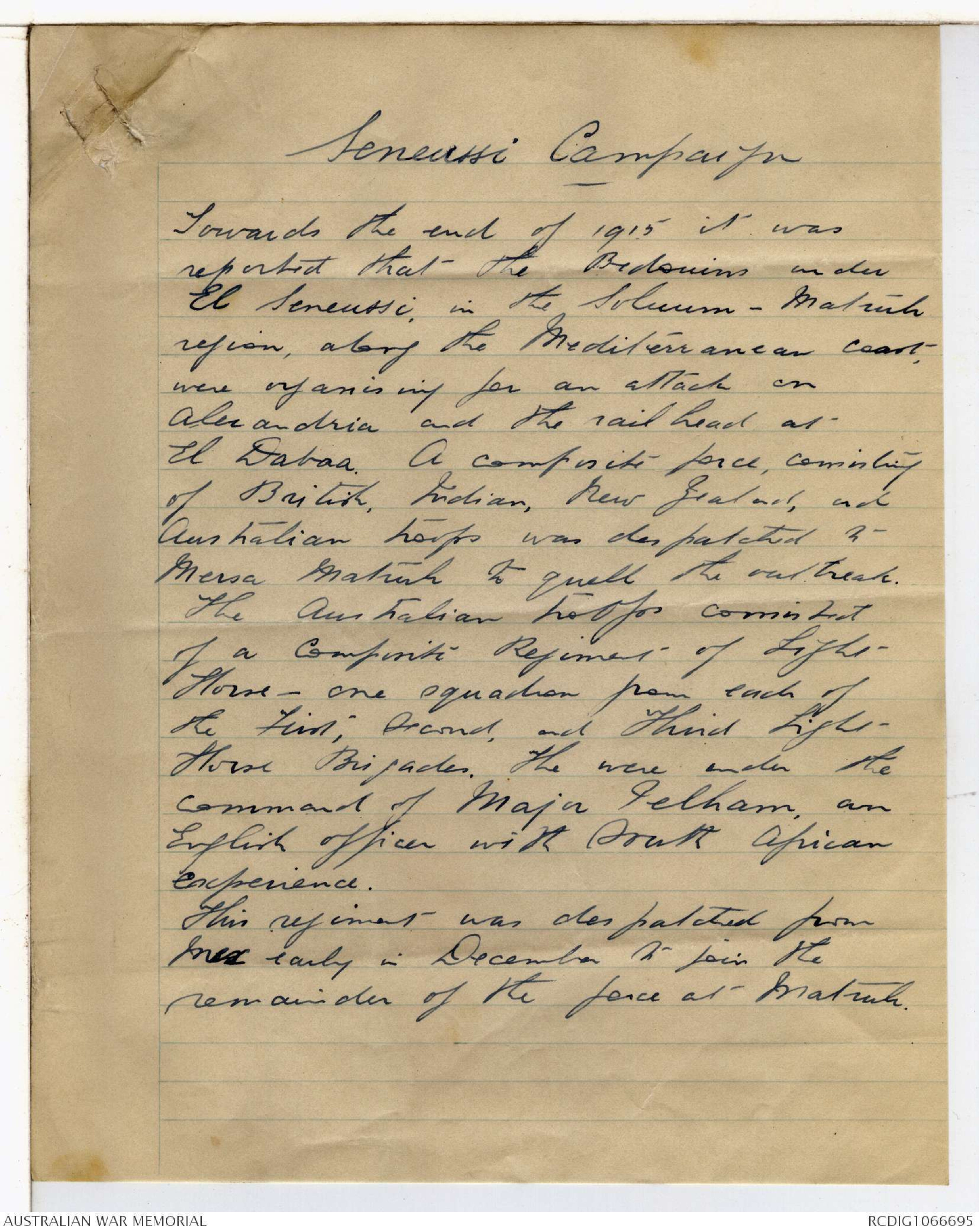
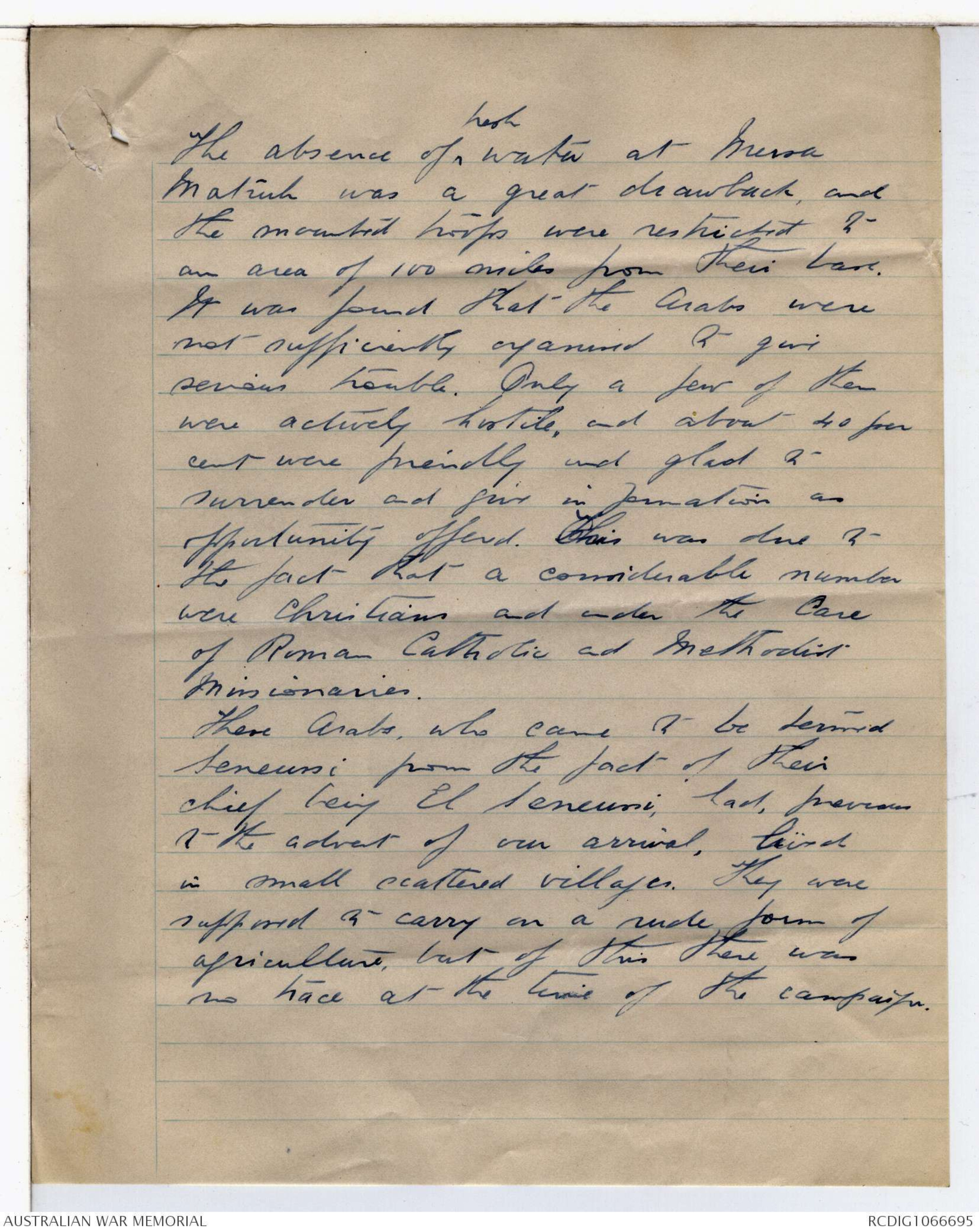
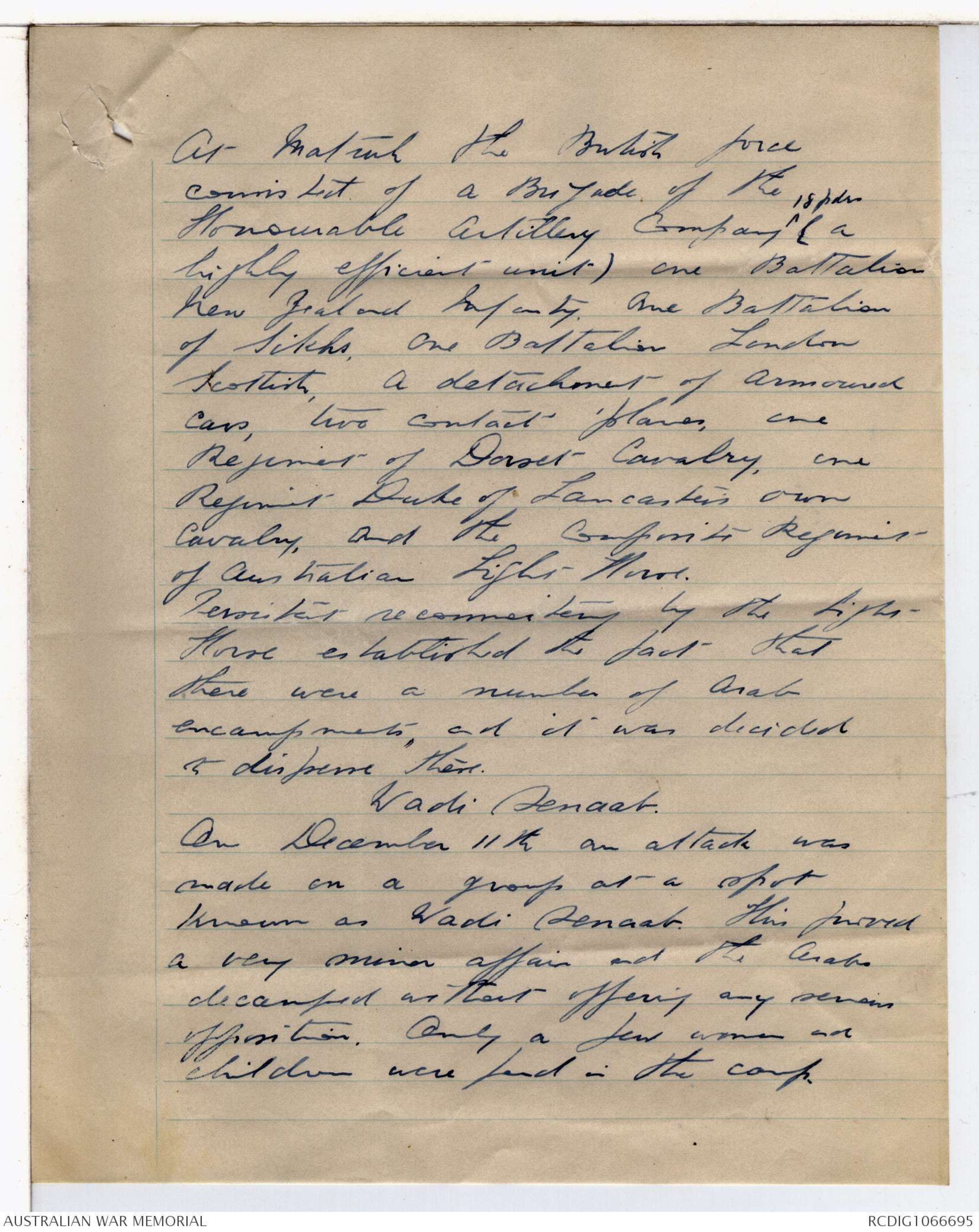
18.
guard. The enemy secured their retreat by holding the high ground
on either side of the pass leading into the Anti-Lebanon, and also by
mounting machine guns in Khan Agash, The regiment withdrew at 6 p.m.
Members of the 9th Light Horse Regiment taken prisoners of war at
Sasa on 29/9/18 were reported in hospital at Damascus.
I have left out all detail from the adjutant’s report, also
names of places you would not find on the map, and if I were to enter
into the movement of all the troops in the regiment this letter would
never be finished. A number of prisoners, including Germans, were
taken during the day, also many machine-guns.
2/10/18. At daybreak I went round and examined the horses' backs
and found very few that had become injured from our strenuous work;
after which I went to brigade headquarters for news. They were
situated some 400 yards from us and on my returning to my regiment
saw that part of it had started to saddle up. What had happened was
[*(?pm)*] this. At 6.15 p.m. Lieutenant Hogan, who was on outpost, had reported
a large column of infantry moving north about a mile and a half north
east of his position. Doubt existed as to whether they were enemy or
Sheriffian Army. A mounted patrol was sent out from “A” Squadron to
investigate and report, and the adjutant had also ordered “B” and “C”
squadrons to turn out in light fighting order. At 6.30 a.m. a few
shots were heard from the direction of the column and the early
morning patrol furnished by the 8th Light Horse Regiment sent back a
message that the column was enemy infantry. The remainder of the
regiment was now ordered to saddle up. Our patrol returned and
confirmed the above report. At 6.45 a.m. the regiment was, less
heavy packs, ordered to move out to attack and cut off the enemy.
The pass leading into the hills west of Khanayash was to be seized
and held and Khan (Inn) Ayash occupied. The regiment moved along the
foothills to the west of the main road. As we moved out a message was
received from brigade headquarters, who had been kept informed of the
enemy movements, etc. (message read "Believe to xbe Germans, move out
at once in and investigate, 8th Light Horse Regiment and 4 machine
guns will be ready to support you if required). “B” Squadron were
advance guard and moved along the road between the xxxxx vineyards.
19.
Major Daly, who had been ever the country the day before, led the
other two squadrons off the road through a track he had discovered.
"B" Squadron had to go another three-quarters of a mile to get round
the end of the vineyard. At troop under Lieutenant Sharp from "A"
squadron had been detailed as right flank guard. The remainder of
"A" and "C" Squadrons moved at a rapid trot and gallop along to the
foothills. At about 7-15 a.me the regiment came under heavy machine-
gun and rifle fire, and at 7-20 a.m. a regimental signal station was
established and the situation reported to the HQ of the brigade. "A"
and "C" squadrons were making good progress through the foothills,
although the enemy were giving them any amount of fire, but the
advance never slackened. The advance guard squadron was passed on its
left flank and then collected. Lieutenant Hogan, who had been on
outpost with his troop had joined up. The whole were then ordered to
occupy a ridge about 800 yards from the enemy. By the time this was
done, "A" and "C" Squadrons had reached the road at the pass, and
the enemy would have to make a desperate fight to get through. Major
Charley’s squadron sent out a couple of troops to pursue the enemy's
advance cavalry, which they captured after one or two exciting little
charges. Major Daly had moved forward to where "B" Squadron had
occupied the position. The enemy by this time showed signs of
weakening, and Major Daly ordered our men to draw swords and advance
at the trot prepared to charge. The Hotchkiss rifles gave covering
fire. At 7.50 a.m. the enemy put up white flags before the charge
developed. In the meantime "A" Squadron had occupied Khan Ayash
just as the enemy were mounting machine-guns in the positions. "C"
squadron under Major Charley had covered 8 miles in an hour, and "A"
squadron about the same distance ever undulating gravel country intersected
with dry wadis. When the main column surrendered Signaller
J.M. Smyth and N.C. Halliday were sent back to regimental headquarters
signal station with a report for brigade. They encountered a German
officer mounting an automatic rifle, and Smyth, with great gallantry,
rushed him and took his pistol from him. Halliday came up in his
support and Smyth shot down the automatic rifle ammunition horses.
The enemy used a few bombs, but so prompt was the attack of these
20.
two signallers that the enemy, believing them to be the advance men of
a stronger force, surrendered, and one German officer, 3 other Huns,
and 85 vTurks were taken. This party had evidently worked down the
dry wadis and might have done great damage by firing in our rear, but
for the prompt action of these two men. They both received the DCM
but unfortunately Smyth had passed away with malaria before he had
heard the news. Just at the time the surrender was taken the balance
of the brigade came in sight along the read and reports were sent to
the general. The captures for ^the hour and five minutes work were
91 officers, 318 cavalry, 1064 infantry, 26 machine guns, 12 automatic
rifles, 1 mountain gun, 2 75mm field pieces, numerous rifles, horses,
and mules. The regimental standard of the 46th Regiment (Turkish
Army) of beautiful red silk with Royal monogram or insignia of the
Ottoman Empire surrounded by laurels etc. on one side, and the
Mohammedan text or belief "There is only one. God and Mohammed is his
Prophet" on the reverse side, all worked in gold. After collecting
the prisoners we returned to our bivouac, having fought the last fight
of the Australians in Palestine and Syria.
The regiment, on April Axts 11th-15th 1916 was the first
regiment to open Sinai-Palestine-Syria campaign, when it visited
Jif Jaffa with a squadron and brought back the remains of the garrison,
so it was only fitting that it should close the campaign so far as the
overseas forces are concerned. During this campaign 1916-18 the
regiment has done 80% of the advance guards in major operations and
covered all withdrawals, which are only three - first Gaza, March
26th 1917, second Gaza, April 19th 1917, and Es Salt, May 1918.
On withdrawing back to bivouac, as our rations for man and horse
were finished, we obtained potatoes and sheep from the inhabitants,
and barley and green maize for the horses. The inhabitants of the
country were very good to us, bringing presents of grapes, eggs,
firewood, etc. They appeared to be a very fine type, and well dressed.
Raisin making was in progress in the locality. We remained in this
bivouac until the afternoon of the 4/10/18, doing patrols and getting
as much rest as possible. We moved back through Damascus to about 8
miles south-west of the city, in which locality we remained until
27/10/18, looking after prisoners of war, finding escorts to take them
21.
back along the lines of communication, etc. During this period, the
effects of the life in the Jordan Valley began to show themselves and
malaria was very prevalent and unfortunately a fair number of deaths
occurred, including Sergeant Foreman, who had just won the D.C.M.,
Signaller Smyth, D.C.M., Trooper (stretcher-bearer) Smith, M.M.
These men all died before they heard of their awards for good work.
On 27/10/18 we moved to Johar via Damascus. 28/10/18, a short march
to Khanayash. 29/10/18, through the Anti-Lebanon hills to Kuteife -
4 hours' march. 30/10/18, marched at 7 a.m., had one hour's halt on
road, and arrived at Nehk at about 5 p.m., where we watered our horses
from a subterranean channel built by the Romans. 3x 31/10/18, moved
off at 5.45 a.m. and watered horses at Kara at 8.30 a.m, where we
breakfasted and moved off at 10.30 a.m. We received orders to push on
to Homs, 50 miles, and to arrive there by dawn on the following
morning, and to rest for 24 hours and then push on to Aleppo by three
marches. At 3.50 p.m. a halt was made to feed up and here we heard
the news of the armistice with Turkey. After feeding we moved 6
miles and had an hour's rest, and moved at 11.30 p.m., and on the
1/11/18 just at daylight we passed through Homs and camped to the
north of the town not far from the River Orontes. Here we remained
till the evening of the 6th, when we started our march to Tripoli,
where we arrived on the afternoon of 9/11/18, enjoying the trip over
the plains which extend to the north from the Lebanon ranges. The
mountains are beautiful, towering as they de, their snow-capped crests
being ever 10,000 feet above sea-level. We camped in the hills about
5 miles S.E. of Tripoli overlooking a beautiful valley and rapid
flowing streams, and under the shadow of the Lebanon ranges.
In the diary I have not dealt with movements outside my own
regiment, nor have I dealt with many brilliant exploits by individual
troops or men, but we received twenty decorations, including three
M.C's, four DCM's, and twelve MM's for our share of the advance.
I have not described the beautiful gardens of Damascus - 80,000
acres of orchards, olive groves, and vineyards watered by the
Barada; nor^ have I xxxx described the mosques or bazaars, the dress and
22/.
habits and many other things of interest in Damascus, and the country
over which we have passed.
I cannot speak too highly of the dash and endurance of the officers
and men, nor of our everlasting friends, our horses. In my yxxxxx
opinion, the secret of the success of the recent operations has been -
(1) a well/conceived plan, well organised in every detail.
(2) secrecy and the principle of mislead, misguide, and
mystify your enemy was carried out to such a degree as to
please the keenest disciple of Stonewall Jackson.
(3) Realisation of the fact that the decisive success can only
be achieved by the assault and the heavy training that the
regiments had gone through prior to moving out had
inculcated the cavalry dash and the spirit of the sword.
(4) The enemy had depended greatly on his machine-guns and
when he was driven into the open the machine guns became a
hindrance. The transport for them was difficult, the
ammunition supply a grave question, and the army was left
without the rifle and bayonet; it is with the shock action
weapon, whether it be sword, lance, or bayonet, that
battles are decided.
(5) The wonderful work carried out by our Royal Air Force and
Australian corps prevented the enemy from getting information
of our movements.
(6) The co-operation between all arms, both on land and sea,
was ideal.
To win wars it is the personal element which will always count,
and not the mechanical devices now used in carrying out war. Machines
of defence and offence are highly important, and when one of the
combatant forces brings forth some ^new engine of destruction the other
side will sooner or later find some method to counteract this and will
employ similar engines themselves. The most powerful means of winning
a war are organisation, administration, discipline, and training. The
last two are those which affect the men who have to do the actual
fighting the most; and it is only by constant attention to detail,
the obedience of orders for which we may see no reason at the time,
and paying attention to the outward and visible signs which indicate
the discipline of a unit may the best the results be obtained. These
results will not be obtained unless training is sound and mistakes,
when made, are pointed out - also, the ceremonial side of training
should never be omitted, as it has a smartening up effect, not only
on the physical side, but also on the mental, and impresses on all the
creed of carrying out an order because it is an order, and teaches the
23.
true meaning of discipline - for the junior to carry out the will of
the senior.
If I get on to the ethereal side as of training, I will bore you
to extinction, so will close this outline diary of the work of the
regiment in which I have not touched on the work of other units, which
were as busy as we were, but I believe the regiment did its fair share
in helping to bring the Turk to a finish.
(ssd) W.H. Scott.
P.S. Amongst prisoners captured by us on 2/10/18 was the
divisional commander who commanded the enemy near Es Salt
during the May operations.
W.H.S.
Nov. 1918.
(Copy of diary sent to Colonel J.M. Arnott, C.M.G., and others.)
Park House
Margaret St
Toowoomba
July 6th 1925.
Dear Mr. Bean
You letter received.
I kept a diary of the Matruh
campaign, but unfortunately it
was destroyed in the dump at
Meteren in 1918.
The Senussi campaign was a squalid
affair - more like murder than
any thing else. They were a helpless
lot, but unfortunately the G.O.C
(General Stoppard) regarded them
as dangerous, ad acted accordingly
Yours Sincerely
DD Hamnay
P.S. Hope you can decipher these, but you
must excuse the scrawl. I have been confined
to bed with a serious cold otherwise I
could have arranged these notes better
DH
Seneussi Campaign
Towards the end of 1915 it was
reported that the Bedouins under
El Seneussi in the Solum - Matruh
region, along the Mediterranean coast,
were organising for an attack on
Alexandria and the rail head at
El Dabaa. A composite force, consisting
of British, Indian, New Zealand, and
Australian hoops was dispatched to
Messa Matruh to quell the outbreak.
The Australian troops consisted
of a composite Regiment of Light
Horse - one squadron from each of
the First, Second, and Third Light
Horse Brigades. The were under the
command of Major Pelham, an
English officer with South African
experience.
This regiment was despatched from
[[?]] early in December to join
remainder of the force at Matruh.
The absence of ^fresh water at Mersa
Matruh was a great drawback, and
the mounted troops were restricted to
an area of 100 miles from their base.
It was found that the Arabs were
not sufficiently organised to give
serious trouble. Only a few of them
were actively hostile, and about 40 per
cent were friendly and glad to
surrender and give information as
opportunity offerd. This was due to
the fact that a considerable number
were Christians and under the Care
of Roman Catholic ad Methodist
Missionaries.
These Arabs, who came to be termed
Seneussi from the fact of their
chief being El Seneussi, had, previous
to the advent of our arrival, lived
in small scattered villages. They were
supposed to carry on a rude form
agriculture, but, of this there was
no trace at the time of the campaign.
At Matruh the British force
consisted of a Brigade of the
Honourable Artillery Company ^18pdrs (a
highly efficient unit) One Battalion
New Zealand Infantry, One Battalion
of Sikhs. One Battalion London
Scottish, a detachment of Armoured
cars, two contact planes, one
Regiment of Dorset Cavalry, one
Regiment Duke of Lancaster's own
cavalry, and the composite Regiment
of Australian Light Horse.
Persistent reconnoitering of Arab
encampments, and it was decided
to disperse them.
Wadi Denaat.
On December 11th an attack was
made on a group at a spot
known as Wadi Denaat This turned
a very minor affair and the Arabs
decamped without offering any serious
opposition. Only a few women and
children were found in the camp.
 Loretta Corbett
Loretta CorbettThis transcription item is now locked to you for editing. To release the lock either Save your changes or Cancel.
This lock will be automatically released after 60 minutes of inactivity.